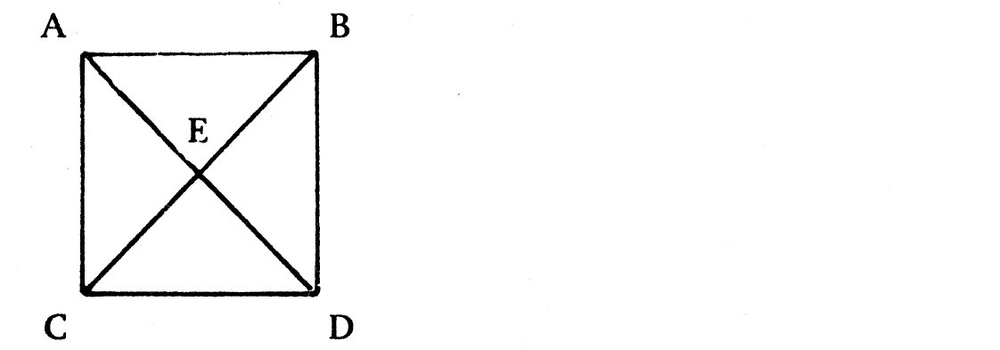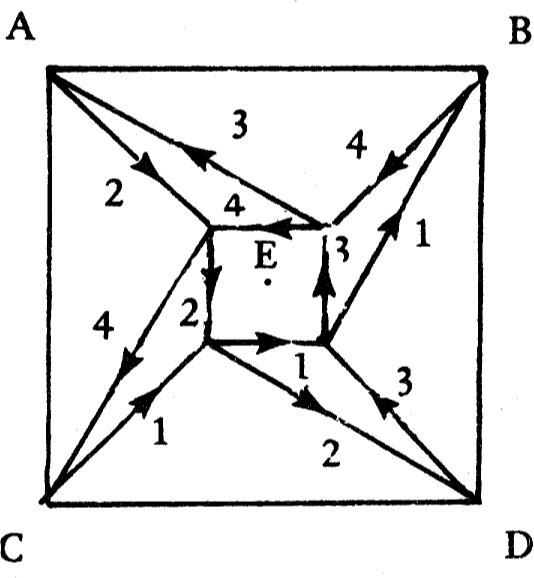The Complete Dramatic Works (59 page)
Read The Complete Dramatic Works Online
Authors: Samuel Beckett

Written in 1981. First performed at Ohio State University in 1981. First published
by Faber and Faber, London, in 1982.
L
=
Listener.
R
=
Reader.
As
alike
in
appearance
as
possible.
Light
on
table
midstage.
Rest
of
stage
in
darkness.
Plain
white
deal
table
say
8’ x
4’.
Two
plain
armless
white
deal
chairs.
L
seated
at
table
facing
front
towards
end
of
long
side
audience
right.
Bowed
head
propped
on
right
hand.
Face
hidden.
Left
hand
on
table.
Long
black
coat.
Long
white
hair.
R
seated
at
table
in
profile
centre
of
short
side
audience
right.
Bowed
head
propped
on
right
hand.
Left
hand
on
table.
Book
on
table
before
him
open
at
last
pages.
Long
black
coat.
Long
white
hair.
Black
wide-brimmed
hat
at
centre
of
table.
Fade
up.
Ten
seconds.
R
turns
page.
Pause.
R:
[
Reading.
]
Little is left to tell. In a last–
[
L
knocks
with
left
hand
on
table.
]
Little is left to tell.
[
Pause.
Knock.
]
In a last attempt to obtain relief he moved from where they had been so long together
to a single room on the far bank. From its single window he could see the downstream
extremity of the Isle of Swans.
[
Pause.
]
Relief he had hoped would flow from unfamiliarity. Unfamiliar room. Unfamiliar scene.
Out to where nothing ever shared. Back to where nothing ever shared. From this he
had once half hoped some measure of relief might flow.
[
Pause
.]
Day after day he could be seen slowly pacing the islet. Hour after hour. In his long
black coat no matter what the weather and old world Latin Quarter hat. At the tip
he would always pause to dwell on the receding stream. How in joyous eddies its two
arms conflowed and flowed united on. Then turn and his slow steps retrace.
[
Pause
.]
In his dreams–
[
Knock.
]
Then turn and his slow steps retrace.
[
Pause.
Knock.
]
In his dreams he had been warned against this change. Seen the dear face and heard
the unspoken words, Stay where we were so long alone together, my shade will comfort
you.
[
Pause.
]
Could he not–
[
Knock.
]
Seen the dear face and heard the unspoken words, Stay where we were so long alone
together, my shade will comfort you.
[
Pause.
Knock.
]
Could he not now turn back? Acknowledge his error and return to where they were once
so long alone together. Alone together so much shared. No. What he had done alone
could not be undone. Nothing he had ever done alone could ever be undone. By him alone.
[
Pause.
]
In this extremity his old terror of night laid hold on him again. After so long a
lapse that as if never been. [
Pause.
Looks
closer.
]
Yes, after so long a lapse that as if never been. Now with redoubled force the fearful
symptoms described at length page forty paragraph four. [
Starts
to
turn
back
the
pages.
Checked
by
L
’s
left
hand.
Resumes
relinquished
page.
]
White nights now again his portion. As when his heart was young. No sleep no braving
sleep till–[
Turns
page.
]–dawn of day.
[
Pause.
]
Little is left to tell. One night–
[
Knock
.]
Little is left to tell.
[
Pause.
Knock
.]
One night as he sat trembling head in hands from head to foot a man appeared to him
and said, I have been sent by–and here he named the dear name–to comfort you. Then
drawing a worn volume from the pocket of his long black coat he sat and read till
dawn. Then disappeared without a word.
[
Pause.
]
Some time later he appeared again at the same hour with the same volume and this time
without preamble sat and read it through again the long night through. Then disappeared
without a word.
[
Pause.
]
So from time to time unheralded he would appear to read the sad tale through again
and the long night away. Then disappear without a word.
[
Pause
.]
With never a word exchanged they grew to be as one.
[
Pause.
]
Till the night came at last when having closed the book and dawn at hand he did not
disappear but sat on without a word.
[
Pause.
]
Finally he said, I have had word from–and here he named the dear name–that I shall
not come again. I saw the dear face and heard the unspoken words, No need to go to
him again, even were it in your power.
[
Pause.
]
So the sad–
[
Knock.
]
Saw the dear face and heard the unspoken words, No need to go to him again, even were
it in your power.
[
Pause.
Knock.
]
So the sad tale a last time told they sat on as though turned to stone. Through the
single window dawn shed no light. From the street no sound of reawakening. Or was
it that buried in who knows what thoughts they paid no
heed? To light of day. To sound of reawakening. What thoughts who knows. Thoughts,
no, not thoughts. Profounds of mind. Buried in who knows what profounds of mind. Of
mindlessness. Whither no light can reach. No sound. So sat on as though turned to
stone. The sad tale a last time told.
[
Pause
.]
Nothing is left to tell.
[
Pause.
R
makes
to
close
book.
Knock.
Book
half
closed
.]
Nothing is left to tell.
[
Pause.
R
closes
book.
Knock.
Silence.
Five
seconds.
Simultaneously
they
lower
their
right
hands
to
table,
raise
their
heads
and
look
at
each
other.
Unblinking.
Expressionless.
Ten
seconds.
Fade
out
.]
Quad
was first transmitted in Germany by Süddeutscher
Rundfunk
in 1982 under the title
Quadrat
1+2.
It was first
transmitted
by BBC2 on 16 December 1982. First published by Faber and Faber, London, in 1984.
A piece for four players, light and percussion.
The players (1, 2, 3, 4) pace the given area, each following his particular course.
Area: square. Length of side: 6 paces.

Course 1: AC, CB, BA, AD, DB, BC, CD, DA
Course 2: BA, AD, DB, BC, CD, DA, AC, CB
Course 3: CD, DA, AC, CB, BA, AD, DB, BC
Course 4: DB, BC, CD, DA, AC, CB, BA, AD
1 enters at A, completes his course and is joined by 3. Together they complete their
courses and are joined by 4. Together all three complete their courses and are joined
by 2. Together all four complete their courses. Exit 1. 2, 3 and 4 continue and complete
their courses. Exit 3. 2 and 4 continue and complete their courses. Exit 4. End of
1st series. 2 continues, opening 2nd series, completes his course and is joined by
1. Etc. Unbroken movement.
| | | 1st series (as above): | 1, 13, 134, 1342, 342, 42 |
| | | 2nd series: | 2, 21, 214, 2143, 143, 43 |
| | | 3rd series: | 3, 32, 321, 3214, 214, 14 |
| | | 4th series: | 4, 43, 432, 4321, 321, 21 |
Four possible solos all given.
Six possible duos all given (two twice).
Four possible trios all given twice.
Without interruption begin repeat and fade out on 1 pacing alone.
(2)
Dim on area from above fading out into dark.
Four sources of differently coloured light clustered together.
Each player has his particular light, to be turned on when he enters, kept on while
he paces, turned off when he exits.
Say 1 white, 2 yellow, 3 blue, 4 red. Then
1st series: white, white + blue, white + blue + red, white + blue + red + yellow,
blue + red + yellow, red + yellow.
2nd series: yellow, yellow + white, yellow + white + red etc.
All possible light combinations given.
Four types of percussion, say drum, gong, triangle, wood block.
Each player has his particular percussion, to sound when he enters, continue while
he paces, cease when he exits.
Say 1 drum, 2 gong, 3 triangle, 4 wood block. Then
1st series: drum, drum + triangle, drum + triangle + wood block etc. Same system as
for light.
All possible percussion combinations given.
Percussion intermittent in all combinations to allow footsteps alone to be heard at
intervals.
Pianissimo throughout.
Percussionists barely visible in shadow on raised podium at back of set.
Each player has his particular sound.
Gowns reaching to ground, cowls hiding faces.
Each player has his particular colour corresponding to his light. 1 white, 2 yellow,
3 blue, 4 red.
All possible costume combinations given.
As alike in build as possible. Short and slight for preference.
Some ballet training desirable. Adolescents a possibility. Sex indifferent.
Raised frontal. Fixed. Both players and percussionists in frame.
(3)
On basis of one pace per second and allowing for time lost at angles and centre approximately
25 minutes.
(4)
Negotiation of E without rupture of rhythm when three or four players cross paths
at this point. Or, if ruptures accepted, how best exploit?
1. This original scenario (
Quad
I
)
was followed in the Stuttgart production by a variation (
Quad
II
).
(5)
2. Abandoned as impracticable. Constant neutral light throughout.
3. Overestimated.
Quad
I
, fast tempo. 15’ approx.
Quad
I
I,
slow tempo, series 1 only, 5’ approx.
4. E supposed a danger zone. Hence deviation. Manoeuvre
established
at outset by first solo at first diagonal (CB). E.g. series 1:

5. No colour, all four in identical white gowns, no percussion, footsteps only sound,
slow tempo, series 1 only.